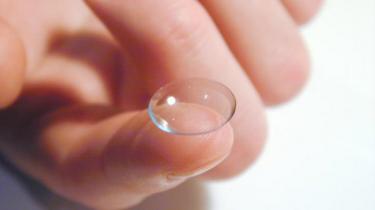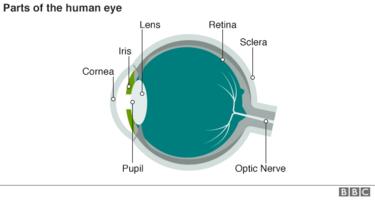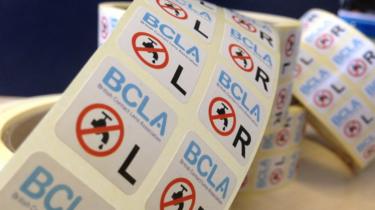MY WORLD OF TRUTH
Thursday, 13 April 2017
I WAS BLINDED BY MY CONTACT LENS
When Irenie Ekkeshis's eye started to itch she assumed it would soon settle down. It didn't. Before long, she found herself in excruciating pain and lost her sight in that eye. And the cause may have been nothing more than handling her contact lenses with wet fingers.
One Saturday morning in January 2011, Irenie Ekkeshis woke up to find her right eye was streaming with tears. So she went to the chemist's and picked up some eye drops.
"I thought I had a little infection that would clear up by Monday. But by that evening I couldn't bear to go in my kitchen because I found the fluorescent lights too bright. It was painful."
Ekkeshis went straight to Moorfield's Eye Hospital where doctors gave her a corneal scrape - a procedure that involves taking cells from the surface of the eyeball.
"It was as horrible as it sounds - you see the needle heading towards your eye. It was excruciatingly painful, even though they use numbing eye drops," she says.
Within days she was told she had Acanthamoeba Keratitis (AK), a rare but serious eye infection caused by a micro-organism that's common in tap water, sea water and swimming pools.
"I was feeling very shocked and frightened, as by then I had lost the vision in my right eye. It was like looking through a foggy bathroom mirror. I could see colours and shapes but not much else," she says.
The illness affects about 125 people in the UK every year - and the vast majority of cases are associated with the use of contact lenses.
"I hadn't had a shower or gone swimming in my lenses," Ekkeshis says. "But I learned that even washing your hands and not drying them properly before handling lenses can cause it."

It was at the age of 12 that Ekkeshis decided to swap her thick glasses for contact lenses.
"I suppose I was a self-conscious pre-teen," she says.
By the time she was 30 she wore daily disposable lenses, the kind you throw away each evening, and she had never had any trouble with them.
But AK, in which an amoeba invades the cornea - the clear front part of the eye - turned out to be a major problem.

At first, Ekkeshis was given antiseptic eye drops to take every hour. She was told that as the infection had been caught early it should be cured in a matter of weeks.
But her eye didn't respond to the treatment, and because the cornea has the highest density of pain receptors in the body, she was soon in agony.
"The pain got worse as the infection developed," she says. "At times it was unbearable and was almost impossible to control, even with the strongest painkillers."
She could not work and eventually quit her job as a travel company director.
Her eye streamed for months until doctors started to get the infection under control. The pain also started to subside. But by now the cornea of her right eye was scarred, leaving her vision in this eye blurred.
Contact lens dos and don'ts
DO:
- Wash and dry your hands before handling your lenses
- Apply your lenses before putting on make-up
- Keep your eyes closed when using hairspray or other aerosols
DON'T:
- Use your lenses for swimming, hot tubs or water sports, unless wearing goggles
- Wear your lenses when showering unless you keep your eyes firmly closed
- Wet your lenses with saliva
Source: Loveyourlenses.com
In May 2013 she had a corneal transplant, which appeared to be a success.
"It was amazing to be able to see through both eyes for the first time in a long time," she says.
However, after 10 days Ekkeshis noticed the sight in her right eye was becoming cloudy again.
"I had a scan which confirmed the AK had moved in to the new transplant. I was back to square one. It was devastating."
 SCIENCE PHOTO LIBRARY
SCIENCE PHOTO LIBRARY
A second transplant followed in 2014.
"My eye stabilised and I was no longer in pain," she says.
However, something then went wrong with her retina and she completely lost her vision in that eye. Doctors have told her they suspect that inflammation caused by AK was the source of the problem - and that her sight is unlikely to return.
During her illness, Ekkeshis discovered that none of her friends or family, many of whom wore contact lenses, knew about the risks of exposing them to water. So she decided to set up a campaign from her sofa to tackle the issue.
She discovered that while a safety leaflet was produced it wasn't usually included inside the lens boxes, so the information rarely reached lens wearers.

She asked the British Contact Lens Association why there was no warning on the boxes. When told there simply wasn't room she designed her own "No Water" graphic.
"At that point the industry realised I was serious and they became supportive. We produced these No Water stickers that opticians could stick on boxes," she says.
Ekkeshis spoke at conferences to promote the campaign and it spread to the US too, after she attracted the attention of the American Academy of Optometry.
She hopes one day the "No Water" graphic will be automatically printed on all contact lens boxes.
Using her campaigning experience, she has co-founded an enterprise called The New Citizenship Project.
"Our purpose is to get people more involved in society. When you think and behave like a citizen you feel able to create change," she says.
Why do lenses increase the risk of AK?
- Contact lens wear causes minor corneal abrasions, which is the key initial step for Acanthamoeba infection
- Contact lenses serve as a vehicle for the harbouring, transmission and delivery of microorganisms to the eye - Acanthamoeba has a high affinity for contact lens surfaces
Source: Journal of Optometry (2009)
Meanwhile Ekkeshis, now 36, has had to adapt to her impaired sight.
"You do things to help cope day to day. So if I'm going to a meal with friends I try to sit closer to the wall on my right side so I can see everyone," she says.
"But it is hard. Sometimes people can get huffy on public transport if you bump in to them because you can't see your right side."
The eyelid is now droopy, which is common in AK.
"My advice to people is simple. Never let your lenses come into contact with water - in the shower, swimming or when washing.
"Although infections like AK are rare, I'm proof they can happen and the results can be devastating."
posted by Davidblogger50 at 01:11

0 Comments:
Post a Comment
<< Home